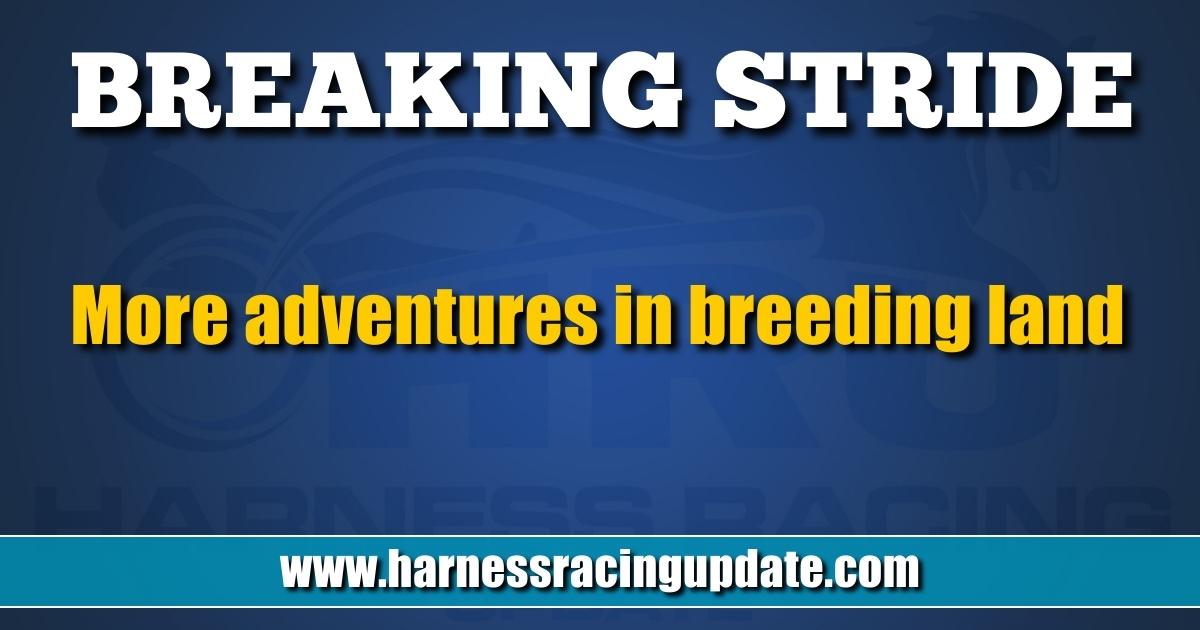More adventures in breeding land
by Trey Nosrac
A few weeks ago, I posted a true saga illustrating the unpredictability of the business of harness racehorse breeding. After pushing the send button, another true story illustrating the point leaped into my brain.
The previous story was about how our top-selling yearling resulted from a complete fluke of nature and zero research. This follow-up report concerns the finest racehorse from our little breeding business (two broodmares and 14 foals in 15 years). Names omitted to protect the innocent.
This breeding story began as usual. My partner and I owned a broodmare about to give birth to her second foal. Shortly after New Year’s, we started shopping for a stallion, confining our choices to Pennsylvania, Ohio, and New Jersey.
We spent weeks and weeks on stallion research. We had dozens of discussions about state programs, yearling prices, breeding prices and countless potential sires. We pored over printouts of performances, pretended to read pedigrees and debated like Clarence Darrow versus William Jennings Bryan. Finally, we made our stallion choice and signed a breeding contract. We chose a brand-new sire, banking on the cache of a first crop in the sales arena.
All proceeded according to plan until it didn’t. Our broodmare produced a fine healthy foal. During our broodmare’s post-birth cycle, insemination with semen from the brand-new, ultra-promising sire took place. We were very excited: until our mare did not get back in foal the first time, the second time, the third time, etc.
The connections of the new stallion contacted us with the troubling news that very few of the mares bred to this stallion got in foal during his first year standing at stud. It happens.
In early June, we stood at the lovely farm where we keep our broodmare and her babies, looking over the fence at our broodmare and her second foal at her side. We were facing a barren season financially and fun-wise, a breeding bummer.
In the distance, from the top of a hill, a resident stallion stood looking back at us over that same fence, pawing the ground, beckoning. This resident stallion’s glory days were behind him, he was well over twenty years old and his annual book of mares bred had dwindled to a pamphlet with less than two dozen pages. Although we respected the heck out of him, this stallion was never on our radar screen. My partner and I looked at each other, shrugged and said: “What the Hell, why not throw a Hail Mary into the end zone?”
One year later, we looked over that fence and watched a fine young colt strolling beside his mother on long, wobbly legs.
With so many strikes against this colt, we did not even send him to market as a yearling. This colt was a late foal from an ancient sire, a marginal maternal family and the first foal of his mare did not make it to the races. We decided to race the colt on the cheap. We sent him out for breaking at a nearby farm, brought him back to stand part of the long winter in the field and sent him to a neighbor to log some miles on a farm track. We staked the colt very lightly and did not send him to a trainer until late February.
Long story short, this afterthought colt was the best racehorse we have produced and raced at the sire stakes level. We sold him halfway through his 3-year-old season and he is still racing competitively at age 5.
This horse and the horse I referenced in the previous column, illustrate something: I’m not sure what. My partner and I have agonized, conjured, forecasted and researched carefully, selecting attractive stallions for our broodmares. Our selection process is a lot of fun, but I do not doubt that professional breeders would roll around on the floor laughing if they listened to tape recordings of our discussions about breeding.
Statistically, according to our small sample size, our sire selection process is flawed. In our case, the bottom line is this: our best seller and best racehorse were the only two foals untouched by our rigorous research, vetting and thinking. Our two panicky, blindfolded, unresearched rolls of the dice were successful, while our brilliant, carefully considered compositions were not. There may be some theory for this phenomenon, like counterintelligence or the Dunning-Kruger effect (a cognitive bias in which people wrongly overestimate their knowledge or ability in a specific area).
Whatever.
Despite our checkered horse breeding past, we are meticulously planning for the 2023 season. We have carefully selected and wildly overspent for a national-level breeding stallion. We also wildly overspent for a new broodmare. We have a detailed plan that has been two years in the making. Everything is in place. Of course, if things go off the rails, there is always a wacky Plan “B.” Time will tell.
You got to love the breeding game.
















